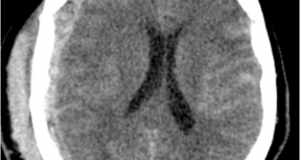In this video, one can appreciate that the patient has a lower motor neuron type of weakness affecting the right facial nerve. On asking the patient to look upwards (stimulation of the frontalis muscles), one can appreciate the lack of wrinkles over the forehead on the right side compared with the left. On asking the subject to close his eyes tight (function of the orbicularis oculi), one can see that the right eyelid closure is significantly impaired with a positive Bell’s phenomenon, where one can see the upward movement of the eyeball.
In the second video, one can see that the right nasolabial folds are attenuated and on asking the patient to show his teeth, the patient is unable to elevate the angle of the mouth (function of the levator anguli oris). When asked the patient to ‘blow out his cheeks’, one can also see that the right side is significantly weaker and air can be forced out due to the weakened orbicularis oris sphincter. This patient had a facial nerve palsy secondary to varicella-zoster virus infection (Ramsay Hunt syndrome).
 HKU E-learning Platform in Clinical Neurosciences HKU eLearning Platform in Clinical Neurosciences
HKU E-learning Platform in Clinical Neurosciences HKU eLearning Platform in Clinical Neurosciences




